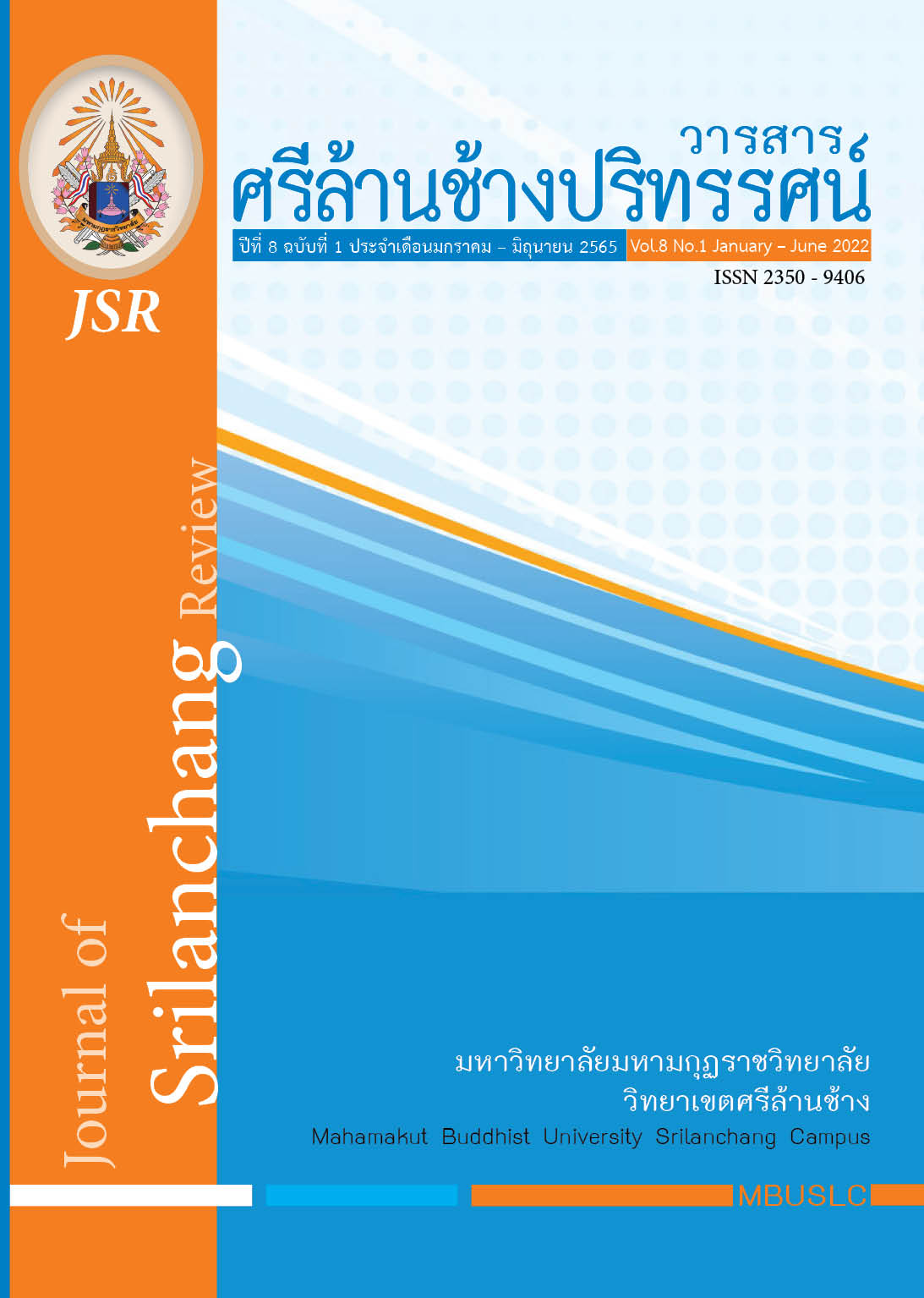DEVELOPMENT OF CRITICAL THINKING ABILITY TEST FOR MATHAYOMSUKSA 1 STUDENTS UNDER SECONDARY EDUCATIONAL SERVICE AREA OFFICE BUENGKAN THROUGH 3PL IRT MODEL
Main Article Content
Abstract
The objectives of the research article were to construct the critical thinking ability test for Mathayomsuksa 1 students in the schools under Secondary Educational Service Area Office Buengkan by applying the three Parameter Logistic (3PL) Item Response Theory (IRS) Model, and to discover the quality of the critical thinking ability test. The population of the research was a total of 3,702 Mathayomsuksa 1 students in the schools under Secondary Educational Service Area Office Buengkan, studying in the first semester of the academic year 2564; 738 research samples were selected through the multi-stage sampling. The construct validity of the test was investigated by the confirmatory factor analysis (CFA) and the quality analysis of the test based on the 3PL IRS model. The research result revealed that the 39-item critical thinking ability test for Mathayomsuksa 1 students in the schools under Secondary Educational Service Area Office Buengkan was the four-choice situational measure, consisting of five factors: seven-item inference, seven-item recognition of assumption, eight-item deduction, nine-item interpretation, and eight-item evaluation of argument. According to the examination of the test quality, the item-objective congruence (IOC) of the test was between 0.80 – 1.00; its construct validity was available. The model was consistent with empirical data (GFI = 0.90, AGFI = 0.89, CFI = 0.93, RMSEA = 0.025), the item discrimination ranged from 0.93 to 2.31, the item difficulty ranged from -0.90 to 1.37, and the guessing parameter or the pseudo-chance score level ranged from 0.10 to 0.28. The item information function was mostly peak at the moderate level of critical thinking ability, and the test information function was peak at the moderate level of critical thinking ability.
Article Details

This work is licensed under a Creative Commons Attribution-NonCommercial-NoDerivatives 4.0 International License.
บทความที่ได้รับการพิจารณาจากคณะกรรมการผู้ทรงคุณวุฒิและเผยแผ่ในวารสารฉบับนี้ เป็นทัศนคติและข้อคิดเห็นส่วนบุคคลของผู้เขียนแต่ละท่าน ไม่ถือว่าเป็นทัศนะคติและความรับผิดชอบ
ของบรรณาธิการ
บทความ ข้อมูล เนื้อหา รูปภาพ ฯลฯ ที่ได้รับการตีพิมพ์ในวารสารศรีล้านช้างปริทรรศน์ ถือเป็นลิขสิทธิ์ของวารสารศรีล้านช้างปริทรรศน์ หากบุคคลหรือหน่วยงานใดต้องการนำทั้งหมดหรือส่วนหนึ่งส่วนใดไปเผยแพร่ต่อหรือเพื่อกระทำการใด ๆ จะต้องได้รับอนุญาตเป็นลายลักอักษรจากวารสารศรีล้านช้างปริทรรศน์ ก่อนเท่านั้น
References
กระทรวงศึกษาธิการ. (2551). หลักสูตรแกนกลางการศึกษาขั้นพื้นฐาน พุทธศักราช 2551. กรุงเทพมหานคร: โรงพิมพ์ชุมนุมสหกรณ์การเกษตรแห่งประเทศไทย.
ประพันธ์ศิริ สุเสารัจ. (2556). การพัฒนาการคิด (ฉบับปรับปรุงใหม่). พิมพ์ครั้งที่ 5. กรุงเทพมหานคร. โรงพิมพ์ห้างหุ้นส่วนจำกัด 9119 เทคนิคพริ้นติ้ง.
พัชรินทร์ ชมภูวิเศษ. (2559). การวัดและประเมินผลการศึกษา. อุดรธานี: คณะครุศาสตร์ มหาวิทยาลัยราชภัฏอุดรธานี.
พัชริน สุภารี. (2550). การสร้างแบบวัดการคิดอย่างมีวิจารณญาณสำหรับนักเรียนชั้นมัธยมศึกษาปีที่ 3 ในโรงเรียนสังกัดสำนักงานเขตพื้นที่การศึกษาร้อยเอ็ดเขต 1. วิทยานิพนธ์ ศษ.ม. (การวัดและประเมินผลการศึกษา). ขอนแก่น: บัณฑิตวิทยาลัย มหาวิทยาลัยขอนแก่น.
ภัทริกา ทองยา. (2560). การพัฒนาแบบวัดความสามารถด้านการคิดวิเคราะห์ตามแนวคิดของมาร์ซาโน ในวิชาสุขศึกษาสำหรับนักเรียนชั้นมัธยมศึกษาปีที่ 4. วิทยานิพนธ์ ศษ.ม. (การวัดและประเมินผลการศึกษา). ขอนแก่น: บัณฑิตวิทยาลัย มหาวิทยาลัยขอนแก่น.
วิจารณ์ พานิช. (2555). วิถีสร้างการเรียนรู้เพื่อศิษย์ในศตวรรษที่ 21. กรุงเทพมหานคร: มูลนิธิสดศรีสฤษดิ์วงศ์.
ศศิธร พาบุ. (2559). การสร้างแบบทดสอบแบบปรับเหมาะกับความสามารถผู้สอบที่ดำเนินการสอบด้วยคอมพิวเตอร์ วิชาเคมี เรื่อง กรด-เบส สำหรับนักเรียนชั้นมัธยมศึกษาปีที่ 5. วิทยานิพนธ์ ศษ.ม. (การวัดผลการศึกษา). มหาสารคาม: บัณฑิตวิทยาลัย มหาวิทยาลัยมหาสารคาม.
ศิริชัย กาญจนวาสี. (2555). ทฤษฎีการทดสอบแนวใหม่. พิมพ์ครั้งที่ 4. กรุงเทพฯ: โรงพิมพ์แห่งจุฬาลงกรณ์มหาวิทยาลัย.
อุมาวรรณ แสงสนิท. (2558). การพัฒนาแบบทดสอบมาตรฐานวัดผลสัมฤทธิ์ทางการเรียนวิชา เทคโนโลยีสารสนเทศ เรื่อง องค์ประกอบของคอมพิวเตอร์โดยประยุกต์ใช้ทฤษฎีการตอบสนองข้อสอบ สำหรับนักเรียนชั้นมัธยมศึกษาปีที่ 1. วิทยานิพนธ์ ค.ม. (วิจัยและประเมินผลการศึกษา). กาญจนบุรี: บัณฑิตวิทยาลัย มหาวิทยาลัยราชภัฏกาญจนบุรี
Watson, G. and E.M. Glaser. (1964). Watson-Glaser Critical Thinking Appraisal Manual. New York: Harcourt, Brace and World, Inc.


